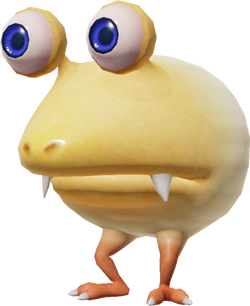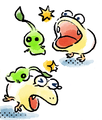Albino Dwarf Bulborb
| |||
|---|---|---|---|

| |||
| Appears in | Pikmin 4 | ||
| Scientific name | Oculus kageyamii larva (1st molt) | ||
| Family | Grub-dog | ||
| Areas | None | ||
| Caves | Kingdom of Beasts, Engulfed Castle | ||
| Night expeditions | Ancient Arches, Stargazer's Spot | ||
| Dandori Challenge stages | None | ||
| Dandori Battle stages | None | ||
| Attacks | Eats Pikmin | ||
The Albino Dwarf Bulborb (コチャッピーモドキ?, lit.: "Pseudo Small Chappy") is a nocturnal enemy found in Pikmin 4. Albino Dwarf Bulborbs resemble Dwarf Bulborbs in appearance, but have white to red back instead of a spotted one, similar to Bulborb Larvae, and additionally have slightly larger snouts compared to most Dwarf Bulborbs. These differences largely stem from both their very young age, being the first molt of a Bulborb Larva, and because they are true members of the grub-dog family rather than breadbug mimics.
Despite being their young, adult Bulborbs are known to cannibalize them. To avoid this, they are only active at night and in caverns, where the poor visibility allows them to evade predation. Albino Dwarf Bulborbs are noticeably tougher than Dwarf Bulborbs, requiring two direct Pikmin throws to the back to dispatch.
Stats[edit]
| Weight | Max. carriers |
Seeds | Value | Health |
|---|---|---|---|---|
| 3 | 6 | 3[note 1] (0 glow pellets) | 200 |
- ^ This enemy cannot be delivered to Onions in-game. This information is obtained from the in-game Piklopedia.
Behavior[edit]
Similar to Dwarf Bulborbs, Albino Dwarf Bulborbs spend most of their time wandering around a small area idly. When they notice a leader or Pikmin, they will begin to chase after them. Like most Bulborbs, if led outside of their territory, they will give up the chase and return to it to resume idly wandering. Albino Dwarf Bulborbs attack by attempting to eat Pikmin. It can only grab and eat a singular Pikmin with each bite and they take a good amount of time to chew and swallow their catch, allowing a swift player to rescue a bitten Pikmin before it is consumed. It can also shake Pikmin off if it is being attacked. When killed, it will safely release any Pikmin in its mouth that it had yet to fully consume.
Exclusively on the second sublevel of the Engulfed Castle, they can be found following an adult Bulborb around, much like how Dwarf Bulbears follow Spotty Bulbears, suggesting an occasional reliance on an adult grub-dog to hunt. It is also likely a reference to Bulbmin, as Sublevel 2 of the Submerged Castle contains them, and the controllable Bulbmin follow their leader in a similar way.
Locations[edit]
Caves[edit]
- Kingdom of Beasts
- Three Albino Dwarf Bulborbs can be seen on sublevel 4. They are all found in the area opposite the S.S. Beagle behind the iron fence. The three of them share this space with a Whiptongue Bulborb. The best way to reach them is either by lowering the iron fence with the button or by swimming through the small body of water as it allows for Oatchi to be brought along making the fight easier.
Night Expedition[edit]
- Sun-Speckled Terrace
- Twenty four Albino Dwarf Bulborbs are in the 'Ancient Arches' expedition.
- Hero's Hideaway
- Eighteen Albino Dwarf Bulborbs are in the 'Stargazers's Spot' expedition.
Strategy[edit]
|
The following article or section contains guides. |
Pikmin[edit]
Auto lock on makes squishing the beasts a breeze, though charging is still effective. They take 2 direct hits to kill, which you will need to mentally count when fighting swarms of them. If possible, use Purple Pikmin to easily kill hordes with its ground pound.
Leaders[edit]
Simply punching while avoiding its attacks is the most effective strategy for leaders, although this takes a noticeable amount of time, even with the Triple Threat upgrade. Oatchi can handle large groups on his own depending on his upgrades, a very useful tactic during night expeditions. A leveled up rush can instantly kill and pass through large groups as well.
Notes[edit]
Dalmo's notes[edit]
Olimar's notes[edit]
“A Bulborb larva after its first molt. Due to its pale coloration, it was assumed to be a mimic when it was first discovered. It was later confirmed to be a true Dwarf Bulborb.
To avoid predation from adult Bulborbs, it spends the majority of the daytime hours hiding underground. It becomes more active at night, when its paler coloration is more difficult to see.
In this state, it is difficult to discern what species of Bulborb any given juvenile may be by appearance alone. It's only after a Bulborb's second molt that they start to display more distinguishing species characteristics.”Louie's notes[edit]
Pikmin Garden[edit]
Text
“デメマダラの二齢幼生。斑紋が薄く、成体に誤って捕食されてしまうのを避けるため、昼間は地下などに潜み、夜になると地上に現れ活動する。
特徴 その1 本物のコチャッピー
- パンモドキ科のコチャッピーよりも後に発見されたため、本物の幼生であるにもかかわらず、コチャッピーモドキと名付けられた。
- (Image text: 成体のデメマダラと同様に、鼻先が少し細くなっている)
特徴 その2 どのデメマダラ?
- 二齢までは、どのデメマダラの幼生か見た目で判別するのは難しい。
特徴 その3 夜行性
- 夜になると活発になり、成体と同様に目が赤く光る。”
Translation
“A second instar Bulborb larva. Its spots are faint, and to avoid accidental predation by adults, it hides underground during the day, and at night it emerges above ground and becomes active.
Feature #1: A true Dwarf Bulborb
- Because it was discovered later than the Dwarf Bulborb, it was named Albino Dwarf Bulborb, even though it is a real larva.
- (Image text: "Like the adult Bulborb, the tip of the snout is slightly tapered")
Feature #2: Which Bulborb?
- Until the second instar, it is difficult to tell which Bulborb larva is which by appearance.
Feature #3: Nocturnality
- It becomes active at night, and its eyes glow red like those of the adults.”
Other information[edit]
- Pikmin 4 Piklopedia number: #2
Naming[edit]
- See more: Grub-dog family#Naming.
- Common name: Albino Dwarf Bulborb
- Japanese nickname: コチャッピーモドキ?. コチャッピー? is the Japanese name for the Dwarf Bulborb. モドキ? can mean "pseudo", referring how it is a "pseudo-Dwarf Bulborb".
- Japanese name: デメマダラ 二齢幼生?, lit.: "Spotted Bug-eye (Second instar larva)". デメマダラ? is the Japanese name of the Bulborb Larva. 二齢幼生? refers to how it is a Bulborb larva in its second instar.
- Scientific name: Oculus kageyamii larva (1st molt). Oculus kageyamii larva is the scientific name of the larvae of Bulborbs, as seen in the Bulborb Larva. The first molt refers to how it is a Bulborb larva after the first molt.
- Internal names:
KOCHAPPY_NIGHT. "Ko Chappy" is the Japanese name for Dwarf Bulborbs. The night distinction refers to these creatures more commonly appearing during night expeditions. - Prerelease: Unknown
Names in other languages[edit]
| Language | Name | Meaning | Notes |
|---|---|---|---|
| コチャッピーモドキ? Ko Chappī Modoki |
Pseudo Small Chappy | "Chappy" is the Japanese name for Bulborb | |
(traditional) |
小恰比擬態蟲 Xiǎo Qiàbǐ Nǐtàichóng |
Small Chappy Mimic Bug | "Qiàbǐ" is the Chinese (traditional) name for Bulborb |
(simplified) |
小恰比拟态虫 Xiǎo Qiàbǐ Nǐtàichóng |
Small Chappy Mimic Bug | "Qiàbǐ" is the Chinese (simplified) name for Bulborb |
| Albinodwergbulborb | Albino dwarf bulborb | ||
| Bulborbe nain albinos | Albino dwarf bulborb | From "Bulb" (Protubering) and "orbe" (Orb). "Bulborbe" is the French name for Bulborb, and "nain" means Dwarf, which refers to its small size. "Albinos" refers to its pigmentation. | |
| Albino-Zwerg-Punktkäfer | Albino Dwarf Dot Beetle | "Punktkäfer" is the German name for Bulborb | |
| Coleto nano albino | Albino dwarf bulborb | "Coleto" may come from "boletus" (Latin for mushroom), as a bulborb's spots resemble those found on certain mushrooms
"Coleto" is the Italian name for both Bulborb and Bulbear | |
| 꼬마차피닮은꼴 Kkoma-Chapi-Dalmeunkkol |
Little chapi look-alike | "Chapi" is the Korean name for Bulborb | |
| Bulbolho-anão albino | Albino dwarf bulbeye | "Bulbolho" is a portmanteau of "bulbo" (bulb) and "olho" (eye) "Bulbolho" is the Brazilian Portuguese name for Bulborb | |
| Bulbo albino enano | Dwarf albino bulb | "Bulbo" is the Spanish name for Bulborb |
Trivia[edit]
- Curiously, despite being true juvenile Bulborbs, the Japanese name for an Albino Dwarf Bulborb still refers to them using the psuedo- prefix.
- This is also shown in the Korean name, which (when roughly translated) says it's a look-alike to a Dwarf Bulborb.
- Their Chinese name similarly roughly refers to them as "Chappy mimics".
Gallery[edit]
Albino Dwarf Bulborbs under the effects of the Lumiknoll's glow.
Albino Dwarf Bulborbs biting a Tricknoll.
An Albino Dwarf Bulborb squished as a Glow Pikmin is thrown on its back.
An Albino Dwarf Bulborb shaking off a Glow Pikmin.
A group of Albino Dwarf Bulborbs in Kingdom of Beasts.
Two defeated Albino Dwarf Bulborbs on sublevel two of the Engulfed Castle.
Two Albino Dwarf Bulborbs attacking Glow Pikmin as seen in the "Once Upon a Creature" comic.








